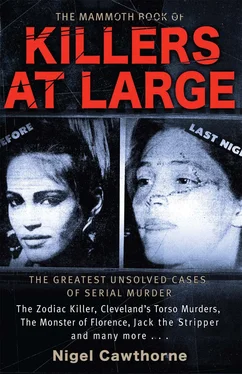The brother of the woman found on 13 February identified her as 22-year-old Nelsiwe Langa. She had last been seen two weeks before her remains were found. Despite the obvious similarities with the Cleveland murders, the police maintain that a different man was responsible. However, other bodies found near Atteridgeville, outside Pretoria showed an almost identical modus operandi to the Cleveland cases.
The township of Atteridgeville has hosted an extraordinary concentration of serial killers. In 1956 the “Atteridgeville Mutilator” killed six boys over five months, mutilating their bodies. He was never caught or identified. In the 1960s Elias Xitavhudzi, known as “Pangaman”, murdered 16 white women and dumped their bodies around Atteridgeville, before being caught and executed. His sobriquet comes from the panga —an African version of the machete used for cutting sugar cane in KwaZulu-Natal—which he used to despatch his victims. Then in the 1970s, there was “Ironman” who robbed his victims late at night before bludgeoning them to death with an iron bar. Ironman took the lives of at least seven victims in this manner before disappearing. He has never been identified.
A half-naked woman’s body was found on 4 January 1995 in a field outside Atteridgeville. It was severely decomposed and she was never identified. On 9 February a second body was found. This woman was completely naked, though her clothes had been piled on her chest and held in place by rocks. Identified from her fingerprints, she was 27-year-old Beauty Nuku Soko, who had disappeared on her way to visit her sister in Klipgat, 20 miles to the north. Four days later Nelsiwe Langa was found.
On 6 March, workmen digging a ditch in Atteridgeville found a woman’s breasts poking out of the soil. They unearthed the body of 25-year-old Sara Matlakala Mokono, who was last seen three days before, on her way to see a potential employer.
On 12 April, another body was discovered in the veldt near the Skurweberg shooting range in Atteridgeville. She was partially naked. Her hands had been tied behind her back with a bra and she had been strangled with a ligature. Most of her clothes were found scattered around the area, but her panties were missing. She was later identified as 25-year-old Letta Nomthandazo Ndlangamandla, a black woman whose profile exactly fitted the victims of David Selepe. The police warned the media that another serial killer might be at large, possibly a copycat of the Cleveland killer.
Soon another disturbing discovery was made. Not 22 yards from the place Letta Ndlangamandla had been found, the police discovered the body of a child. It was Letta’s two-year-old son Sibusiso. Earlier in the month, when Letta went to meet a man in Pretoria North who had offered her work, she had no one to leave Sibusiso with, so she took the child with her. They had been dead too long to determine whether the mother or child had died first. Although Sibusiso showed signs of an injury to his head it was not possible to determine if this was the cause of death. This left open the chilling possibility that Sibusiso had died of exposure, alone in a field near his mother’s corpse, too young to summon help.
On 13 May, the body of 29-year-old Esther Moshibudi Mainetja was discovered in a corn field near Hercules, seven miles away in Pretoria West. Last seen the evening before when she left a café to go home, she had been strangled with her own clothing and the lower part of her body was left uncovered.
Over the next month, five women went missing. Then on 13 June the body of 25-year-old Francina Nomsa Sithebe was found. At first sight, she appeared to be sitting against a tree on June 13. She was still wearing her dress. But her panties and handbag strap had been fashioned into a halter that secured her neck to the tree.
The body count continued to rise. On 16 June, the naked body of 19-year-old Elizabeth Granny Mathetsa was found in the industrial district of Rosslyn, ten miles north of Atteridgeville. She had disappeared three weeks before.
Then on 22 June, the body of 30-year-old Ernestina Mohadi Mosebo was found in Rosherville, just outside Johannesburg. The killer had moved to the Cleveland strangler’s stamping ground. Like the Cleveland killer’s victims, Ernestina Mosebo had been raped and strangled. Her papers were found nearby, aiding her identification.
On June 24, the remains of Nikiwe Diko were found back in Atteridgeville. Her body had been torn apart by wild dogs. Her head was found over 40 yards from her trunk. Her hands had been tied together with her panties and she had been strangled with her pantyhose. They had been tied around her neck and wound so tightly with a stick that shards of bone punctured the nylon. Her killer had also shoved a stick up her vagina. Her husband identified her by the wedding ring that remained on her finger. He had last seen her on 7 April, when she had gone to meet someone about a job.
The Atteridge murders were now about to make another curious intersection with the David Selepe case. On 17 July 1995, Absalom Sangweni, who lived in a caravan in Beyers Park, outside David Selepe’s home town of Boksburg, watched as a man and a woman walked into the veldt some way away from his trailer. He called out to them as a fenced section would stop them going far. The man merely shouted back that he knew the area.
Some time later, the man reappeared. This time he was alone. He appeared furtive and ran off. Absalom went into the field to investigate and found the woman. She was lying still on the ground and had plainly been viciously assaulted. He rushed to fetch help. When Sergeant Gideon O’Neil arrived, he found the body still warm, but there was no pulse. Another policeman arrived with a first aid kit, but they could not revive her. The woman had been strangled with the belt of her own dress. There were few clues to the identity of the murderer and Absalom had been too far away to give a useful description of the man. The victim was later identified as 25-year-old mother-of-four Josephine Mantsali Mlangeni. Like the others, she had gone to meet someone about a job.
Although this murder had taken place 30 miles away in the townships of Johannesburg, it fell under the auspices of a special investigating team now set up by the Pretoria Murder and Robbery Unit under Captain Vinol Viljoen. Again profiler Micki Pistorius was brought in. When they combed through the files, they found a confusing picture. The killer showed no clear modus operandi. Some of the victims had their hands tied; others did not. And of those who had been tied, some had their hands behind; others in front. There was even a question whether they had all been murdered by the same man. Soon there was more material to work on.
On 18 July, 21-year-old Granny Dimakatso Ramela was found in Pretoria West, lying face down with a garrotte around her neck. Unusually, she was fully clothed. She had been missing for nine weeks.
On 26 July, the body of 28-year-old Mildred Ntiya Lepule was found in a canal near the Bon Accord Dam at Onderstepoort, just outside Pretoria to the north. Her panties had been drawn over her face and she had been strangled with her tights. She was last seen alive the previous day by her husband, who had taken her to Pretoria to meet a man about a job.
By this time Dr Micki had set up a board in the operations room and arranged the victims in order and spotted a pattern. Rather than killer’s modus operandi being haphazard, it was clear that he had been refining his technique. To start with, the victims had been throttled manually. Then the killer began to strangle them using a ligature, often a bra or some other piece of clothing. Lately he had garrotted them, using a stick to tighten a piece of their clothing around their necks. He was finding out which way worked best.
Читать дальше











